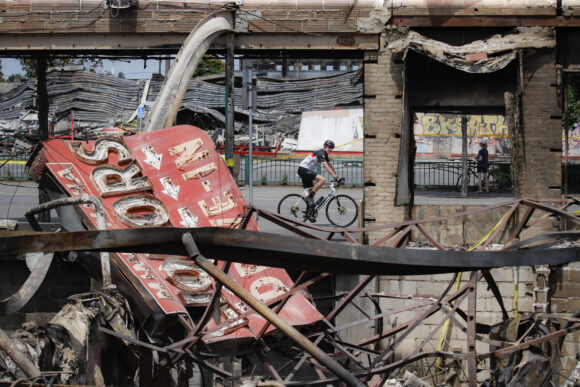Dan Gutlovics did a lot of virtual hand holding during the first days of the violent protests in Minneapolis and St. Paul following the death of George Floyd while in the custody of Minneapolis police on May 25.
Gutlovics, sales executive with Corporate Four Insurance Agency in the Minneapolis suburb of Edina, Minnesota, has commercial insurance clients with businesses in and near the area of Minneapolis that was heavily damaged by the rioting.
Businesses were vandalized and looted, and some were torched during riots that grew out of protests across the country following Floyd’s death.
Gutlovics said during the first few days of the protests he filtered some 35 to 40 “phone calls from customers that were either concerned about what their policy and coverage was going to respond to if something happened, to customers calling in the beginning that have had damage, to customers following up with just concern about things in general.” It was a very crazy time, he added.
His agency was not directly impacted by the violence but some of his customers’ businesses were. In early June, he told Insurance Journal he’d been pouring over his customers’ policies to make sure they have the correct coverages, trying to put them at ease, letting them know they have the proper coverage and letting them know that if they have damages a claim will be filed.
“It’s been a lot of just really trying to help people not have too much fear here in a time where there’s a lot of fear,” he said.
A Deadly Awakening
Minneapolis policeman Derek Chauvin and three other police officers were fired from the Minneapolis Police Department following the incident in which Chauvin pressed his knee on Floyd’s neck for nearly nine minutes while the prone, unarmed, handcuffed man exclaimed that he couldn’t breathe. Chauvin has been charged with second-degree murder without intent, third-degree murder, and second-degree manslaughter. The three officers who stood by and watched without attempting to restrain Chauvin have been charged with aiding and abetting second-degree murder.
The extent of the property damage in the Twin Cities that resulted from the rioting hasn’t been fully assessed, but the Star Tribune reported in early June that the total cost of the damage could rise above $500 million. It is estimated that nearly 1,000 commercial properties were damaged or destroyed in Minneapolis and St. Paul, according to local news sources.
Damage costs from the rioting across the U.S. may rival the 1992 Los Angeles riots to become the costliest civil disorder in the country’s history, insurance experts say. The April and May 1992 civil unrest in Los Angeles following the videotaped police beating of Rodney King caused $775 million in damages — or $1.42 billion in today’s dollars, according to the Insurance Information Institute (I.I.I.).
In Minneapolis, the epicenter of the protests was in the Minneapolis Police Department’s Third Precinct, the headquarters of which was torched and destroyed during the riots. Businesses along Lake Street were severely damaged or destroyed. The Midway region in St. Paul also suffered widespread destruction.
Brian Strub, assistant communications director for the Minnesota Department of Commerce, told Insurance Journal in an email that the department “has not quantified or assessed damage, tallied claims, or made financial estimates or predictions of cost or loss. Local jurisdictions are continuing to conduct damage assessments.”
He said the department is considering the possibility of issuing a data call to insurers regarding claims associated with the protests but that it is too soon to confirm whether that would happen.
Coverage Issues
Gutlovics said after the first night of protests he got a call from one of his clients who owns a pizza restaurant, not on Lake Street but nearby. The owner had boarded up the restaurant’s windows but the protesters “took the boards down, busted the windows, and ultimately ended up breaking in and looting the place,” Gutlovics said.
He told his client initially not to try to clean up or make repairs because it appeared that there would be more unrest, and there was. There was “no point in trying to clean up or fix something up at this point because we don’t know what’s going to happen,” he said.
Another customer had “a restaurant on Lake Street and they were also impacted that first night,” he said. The next night, rioters came back and burned the building down. “Basically, it’s not a normal claim where you’re like, ‘Okay, let’s get started here and get you back up and running.’ It’s a situation where we don’t know when this is going to stop, so there’s no point in doing anything right now, except sit and wait and hopefully things calm down over the next couple of days,” Gutlovics said.
So, his initial advice to impacted clients in the beginning was to hold tight, board up and “try to keep them from coming back and burning your place down. … It was a real different way of thinking than our normal claims process.”
Damage from the protests in most cases “will be a covered event for businesses and homeowners throughout the U.S. The types of claims that are anticipated include physical property damage to facilities, including glass, windows, doors, light fixtures, furniture and merchandise; as well as commercial and personal vehicles. Residential property loss claims are also possible,” said Mark Friedlander, director of Corporate Communications for the I.I.I.
Gutlovics said most of the impacted businesses in his book have standard businessowners policies or a package policy that provides coverage for property and liability. Customers whose businesses suffered physical damage will be covered not only for property damage but because their properties were impacted physically, they will have met the trigger for loss of income as well.
What’s not so clear is what kind of coverage businesses that boarded up and shut down voluntarily in order to stave off losses will have. They might not have had damage though nearby businesses did, he said.
The civil unrest has sparked his clients’ interest in what their policies cover, so Gutlovics is having lots of conversations about coverages and whether they need to increase or modify their policies to better protect their business assets when the carriers regain their appetite for writing business in the impacted areas.
Topics Agencies Talent Property Law Enforcement
Was this article valuable?
Here are more articles you may enjoy.



 Alliant Latest to Sue Howden US Over Alleged ‘Smash-and-Grab’ Poaching
Alliant Latest to Sue Howden US Over Alleged ‘Smash-and-Grab’ Poaching  AIG Announces Strategic Investment Partnership of Up to $3.5B With CVC
AIG Announces Strategic Investment Partnership of Up to $3.5B With CVC  Zurich Makes £7.7 Billion Bid for Specialty Insurer Beazley
Zurich Makes £7.7 Billion Bid for Specialty Insurer Beazley  New York State Police Report 37-Vehicle Pileup on I-81 Near Syracuse
New York State Police Report 37-Vehicle Pileup on I-81 Near Syracuse 


